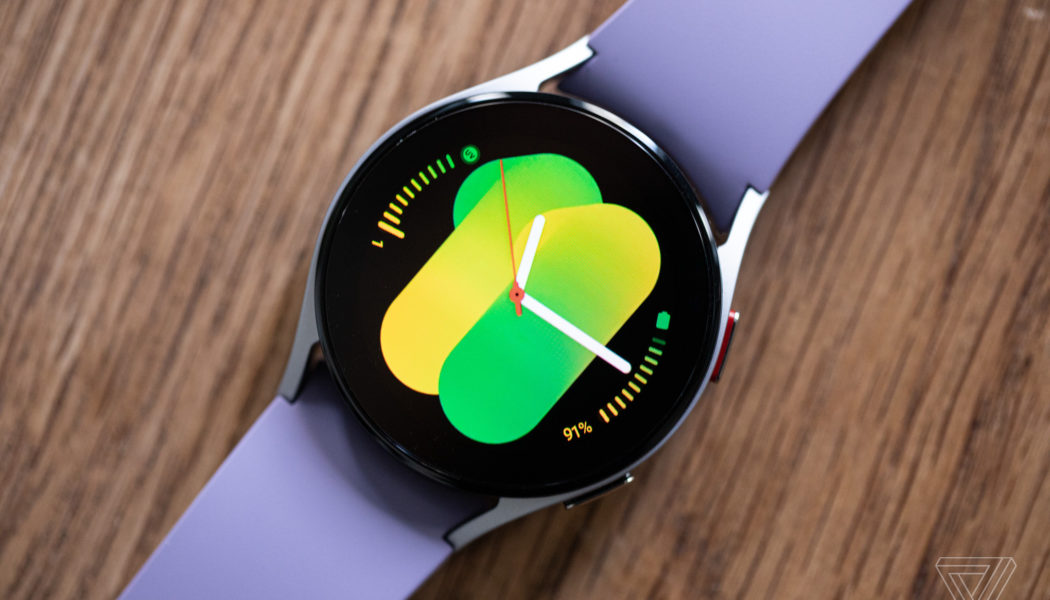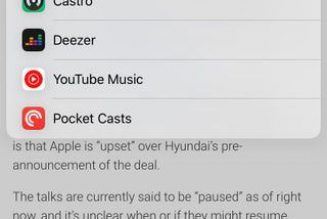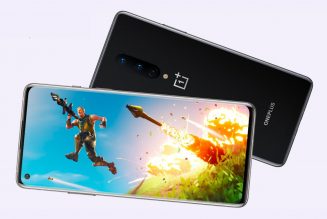After testing Samsung smartwatches, I’m usually left with a furrowed brow, wondering what could have been. It’s not because they’re bad, ugly, or a pain to wear. Actually, it’s the opposite. Hands down, Samsung’s smartwatches are the best Android users can buy right now, and the $279.99 Galaxy Watch 5 is no exception. (Though that may change once the Google Pixel Watch arrives.) If Samsung would fix one — maybe two — things, its smartwatches would make the Apple Watch yesterday’s news. I was hoping to report that Samsung had finally nailed it, but for better or worse, the Watch 5 is more of the same.
I don’t mean this figuratively. The Watch 5 is nearly identical to its predecessor, the Galaxy Watch 4. It comes in the same 40mm and 44mm sizes. Aside from a few new strap colors, it looks the same. I’ve spent years reviewing nearly every smartwatch under the sun, and strap color is the only way I could spot the difference between my Watch 4 and 5 review units at a glance.
The Watch 5 also has many of the same specs as the Watch 4, including the Exynos W920 processor, 1.5GB of RAM, 16GB of internal storage, contactless payments, GPS, optional LTE, contactless payments, and 5ATM of water resistance. You get the same health features via the slightly improved 3-in-1 BioActive sensor — heart rate tracking, ECGs, body composition analysis. Hardware-wise, the only new thing you’re getting is an infrared temperature sensor. That, by the way, doesn’t do much of anything yet. It will allegedly improve sleep tracking accuracy, but as Samsung said during Unpacked, it added the sensor so developers can tinker around creating future health features. As far as software goes, it also runs Wear OS Powered by Samsung (aka Wear OS 3 running a Samsung skin). The Galaxy Watch 5 Pro, which ships alongside the Watch 5 on August 26th, is where you’ll see new design choices and snazzy features like turn-by-turn navigation, but the Watch 5 is a very vanilla update.
I doubt most people will notice the handful of tweaks Samsung has made. The 40mm and 44mm watches are a bit heavier — about the weight of a penny — because they have slightly larger batteries. It’s got a curvier back to ensure better skin contact for greater accuracy. That curved back doesn’t really change how it feels on your wrist. Samsung claims it’s 9.8mm thick, but YouTuber DC Rainmaker found that it’s actually closer to 13mm when you include the sensor bump. But really, you won’t notice it. The Watch 5 also uses sapphire crystal glass for greater durability. That’s great, but it won’t be appreciated by anyone who isn’t a klutz, an adventurer, or an adventurous klutz.
:no_upscale()/cdn.vox-cdn.com/uploads/chorus_asset/file/23952684/akrales_220811_226124_0157.jpg)
Of course, there are new watchface options, too. Some will catch your eye. Some won’t. I happen to dig that you can now add complications to the blobby number face. The new purple dragon face appeals to me, as I’m on a purple gadget kick and a dragon in the Chinese zodiac. But if you don’t like a new (or old) watchface, you’ll hardly notice it’s there because you won’t use it.
The Watch 5 is the definition of an iterative update, but I’d be remiss if I didn’t call out two much-needed improvements.
The most obvious change is that you no longer have to endure Bixby. On-watch Google Assistant was a vague promise when the Galaxy Watch 4 launched last August, but it finally arrived a few months ago. The first thing I did once I unboxed and charged the Watch 5 was download Google Assistant and reprogram the Home button to launch that instead of Bixby. The second thing I did was download Google Wallet, Strava, Spotify, Calm, and a handful of other popular apps. This instantly made for a better experience because I was no longer shackled to Samsung Health, Samsung Pay, Bixby, or Samsung SmartThings. (The Galaxy Wearable app, however, is nonnegotiable.) I can use Strava to track my runs, Google Assistant to control my smart home, and Google Wallet to pay at the drugstore. While the Watch 4 was very much a Samsung smartwatch, the Watch 5 is less so.
:no_upscale()/cdn.vox-cdn.com/uploads/chorus_asset/file/23952683/akrales_220811_226124_0146.jpg)
To be clear, the Watch 5 is still better if you’re on a Samsung phone. For starters, the ECG function only works with Samsung phones, and you’d need a half-dozen third-party apps to replicate all the wellness and fitness features of Samsung Health on a non-Samsung phone. Samsung Pay is also hardcoded as a shortcut when you long-press the back button — and there doesn’t seem to be a way to reprogram it to launch Google Wallet instead. One UI Watch 4.5 — Samsung’s watch interface on top of Watch OS — also gives the Watch 5 the ability to have two phone numbers, but only if it’s paired to a Galaxy phone with dual-SIM support. But if I want to flip Bixby the finger or download half a dozen apps to replace Samsung Health, the Play Store is my oyster. It’s not ideal, but it’s progress from last year and the year before that.
Speaking of One UI Watch 4.5, the updated interface adds a ton of new accessibility features and puts them all in one easy-to-find menu. Some of the new features include visibility enhancements, like high-contrast fonts, color filters, color correction, and the ability to toggle animations or blur effects. You can also tweak Bluetooth headphone settings to adjust the audio balance between each ear. (Though, you can’t do this during calls.) Samsung’s also added the ability to adjust tap duration and disable repeated taps.
:no_upscale()/cdn.vox-cdn.com/uploads/chorus_asset/file/23952681/akrales_220811_226124_0094.jpg)
As a hearing, able-bodied person, I can’t speak authoritatively about how well all of these accessibility features work in everyday life. However, the visibility enhancements significantly improved my ability to read on the 40mm Watch 5. I was born with eyeballs so cursed my eye doctor said “sometimes you have to settle for good enough” when I got my last prescription. I’m also someone with small wrists. As a reviewer, I’m so tired of having to choose between a small watch that’s comfortable to wear and a humongous watch that has an easy-to-read screen. My vision and wrist size aren’t things I can control, but it’s almost comical how much of a difference high-contrast fonts and adding a color filter made. Wearables have a long way to go on the readability front, and I wish more smartwatch makers would follow Samsung’s lead here.
Samsung also made it easier to type on small screens with new keyboard inputs. You can now use dictation, handwriting, and swipe-to-type options. Your mileage may vary, however. I found dictation and handwriting to be useful, but swiping to type on a 40mm screen is just not ideal no matter how you slice it.
:no_upscale()/cdn.vox-cdn.com/uploads/chorus_asset/file/23952679/akrales_220811_226124_0036.jpg)
These are some major improvements, but I can’t help but feel Samsung dropped the ball in a big way when it comes to the touch bezel and battery life.
The touch bezel mimics a physical bezel by letting you slide your finger around the rim of the display to scroll through menus. It was finicky on the Watch 4, but it almost seems worse on the Watch 5. I distinctly remember getting the hang of it on the Watch 4, but I struggled to do so again this year. (I always reached for the Watch 4 Classic whenever I needed to try out new features during the past year, so it’s been a while.) If I swiped too quickly, tiles would zip by faster than my cat running for second breakfast. If I went too slowly, it wouldn’t register at all. It was also much too easy for my finger to slip off the edge or outside the touch bezel area.
Technically, the Watch 5 doesn’t need the touch bezel at all. Wear OS 3 might have some of Tizen’s DNA, but the UI is missing the playfulness that Tizen had when it came to circular menus. Wear OS 3 can be easily navigated with directional swipes alone. (Taps and swipes didn’t register quite as well on the Watch 5, either. That said, I attribute that to my fingers being sweatier than usual thanks to the recent heatwave.)
:no_upscale()/cdn.vox-cdn.com/uploads/chorus_asset/file/23952686/akrales_220811_226124_0228.jpg)
I’ll admit that my disappointment is because I’m a staunch card-carrying member of Team Rotating Bezel. I don’t hate touchscreens or swiping to access menus. It’s much more intuitive for some things, like scrolling through notifications or zooming in on a map. But physical controls have their place. Not only are they accessible but also they’re great for outdoor athletes, as they’re immune to sweaty fingers and gloves. In Samsung’s case, the physical rotating bezel was an iconic calling card that both harkened back to the old Gear lineup and also set it apart from every other circular smartwatch on the market. Plus, the rotating bezel is so much fun to use. Modern gadget design seems all too happy to sacrifice imagination on the altar of sleek minimalism.
Samsung says the physical bezel hasn’t actually gone anywhere because the Galaxy Watch 4 Classic remains in the lineup as the midtier option between the Watch 5 and the Pro. But this also confuses me. You’re… charging more than the newer entry-level watch for the physical bezel, older sensors, and worse battery life? That math doesn’t add up.
Battery life was a major pain point for users of the Watch 4, and Samsung made a point of increasing battery size on the Watch 5. I never managed more than 20 hours with the Watch 4, The numbers I’ve heard from readers over the past year ranged from well under 20 to nearly 40. I frankly don’t think 24 hours on a flagship smartwatch is necessarily a deal-breaker. But several of you asked if the battery life on the Watch 5 was worth upgrading for, so here’s a snapshot of my battery testing this past week.
- Heavy usage day: always-on display (AOD) enabled, “Hey Google” wake word enabled for Google Assistant, 60 minutes of GPS activity without my phone and no music streaming. Started with 100 percent at 9AM, ended up with 9 percent at 5PM. Had to charge before heading home and got 38 percent battery after a half hour. Woke up with 2 percent battery the next morning after wearing it overnight.
- Medium usage day: AOD disabled, “Hey Google” enabled, 30 minutes of GPS activity without my phone while streaming music from an offline playlist to my headphones. That half-hour run zapped 21 percent of the battery, and I ended the day with 55 percent left.
- Light usage day: AOD and “Hey Google” disabled, 50-minute GPS run with no music and my phone. Spent the majority of the day on the couch or napping. My run ate 12 percent of the battery, and I ended the day with 45 percent.
Battery estimates are heavily dependent on individual usage and preferred settings, but in a whole week, I never got close to Samsung’s 40–50 hour estimate. Even when I disabled battery-guzzling settings, minimized syncing, and turned off notifications, I still had to charge daily. And I didn’t even have the LTE version! I suspect the larger 44mm will perform better simply because it has a larger battery, but this still pales to the two to three days you used to consistently get on the Watch 3.
:no_upscale()/cdn.vox-cdn.com/uploads/chorus_asset/file/23952685/akrales_220811_226124_0175.jpg)
It helps that the Watch 5 has faster charging. (Also, the charger can now plug into a USB-C brick!) You still need about two hours to go from zero to 100 percent, but a half hour gets you anywhere between 30–40 percent. That’s enough to get you home or power a night of sleep tracking.
As far as health and fitness tracking go, the Watch 5 is a good but imperfect option. Heart rate and distance tracking were on par with the Apple Watch Series 7 on the five runs and six walks I recorded this past week. Samsung’s automatic walk detection also remains one of the best. The Samsung Health app isn’t good if you like competing with friends, but I’ve seen much worse. Samsung’s sleep tracking is the most advanced it’s ever been, but it’s still a mixed bag. While you can get in-depth sleep coaching, you need seven full days of eligible sleep data to get a single insight. I’ve only just started getting tips, so I can’t say how well this feature works long-term just yet. I’ll have a better idea when I review the Watch 5 Pro. (Long lead times are good when collecting health data but not always helpful when you’re writing product reviews.) There were some notable discrepancies with my Oura Ring and the Eight Sleep Pod 2 Pro Cover when it came to sleep stages, particularly REM sleep. I’m not too pressed by that, however. You should take most sleep stage data with a heavy pinch of salt. What’s more important is that, like Santa Claus, the Watch 5 knew when I was sleeping and when I was awake.
:no_upscale()/cdn.vox-cdn.com/uploads/chorus_asset/file/23952682/akrales_220811_226124_0124.jpg)
I was less impressed with Samsung’s blood oxygen data. Nearly every night, the Samsung Health app said I had a “minimum” blood oxygen saturation between 80 and 88 percent. For reference, a healthy range is considered 95–100 percent; 88–92 percent is considered the minimum safe range for patients with moderate to severe chronic obstructive pulmonary disease (COPD). A reading of 80 percent warrants hospitalization. I’ve tested so many sleep wearables that I know these aren’t reflective of my actual sleeping SpO2. It’s likely I got these numbers because I’m a side sleeper, and have experienced similar results using Garmin watches. But the way Samsung presents this data can cause unnecessary panic because you don’t immediately see a graph or educational text next to the scary number. You have to tap to get further information and even then the graph doesn’t visualize the information well. You need look no further than the concern that a broken SpO2 graph caused among Fitbit users to see why data presentation and education matter. Hopefully Samsung addresses this in a future update.
For all my gripes, this is the best Android smartwatch right now for folks who want superior connectivity, robust third-party apps, advanced health features, and casual fitness tracking. Sure, the starting price is $30 more than its predecessor, but these are inflationary times. For the feature set, the Galaxy Watch 5 is a reasonable price at $279.99 for the 40mm and $309.99 for the 44mm. (LTE options cost $50 more.) The Apple Watch SE starts at the same price and has a similar feature set — so Samsung isn’t overcharging. Meanwhile, the Watch 5 has more advanced features and sensors that generally outperform the $329.95 Fitbit Sense, the $299 Fossil Gen 6, and the $299.99 Mobvoi TicWatch Pro 3 Ultra GPS.
:no_upscale()/cdn.vox-cdn.com/uploads/chorus_asset/file/23952680/akrales_220811_226124_0082.jpg)
If you’re wondering about upgrading from the Watch 4, I wouldn’t unless you see a great deal or take advantage of a trade-in offer. You’ve already got what makes the Watch 5 great on your wrist and the battery improvements aren’t good enough. It’s a different story if you’ve got a Samsung phone and have been holding onto your Galaxy Watch Active or Active 2. Samsung will be ending support for these devices soon, you’ve been without a physical bezel this whole time so you won’t miss it, and you’re going to get a better overall experience on the Watch 5. Watch 3 and Watch 4 Classic owners should sit tight to see if Samsung realizes it goofed by not making a Watch 5 Classic.
If you’re not already on a Samsung phone, you should wait to upgrade. The Watch 5 is the best you can buy right now, but that might change in a few short weeks. Google is launching the Pixel Watch this fall. Qualcomm’s finally getting its act together with the Snapdragon W5 Plus platform, meaning Wear OS 3 watches might soon get an even more powerful chip than the one powering the Watch 5. That chip could very well power Fossil’s next-gen smartwatches. And if you’d like to really take your time to see how the dust settles, certain Wear OS 2 watches are slated to get an optional upgrade to Wear OS 3 before the end of the year. Android users, y’all are about to get more smartwatch options than you’ve ever had before. The Galaxy Watch 5 isn’t going anywhere. What’s the rush?









